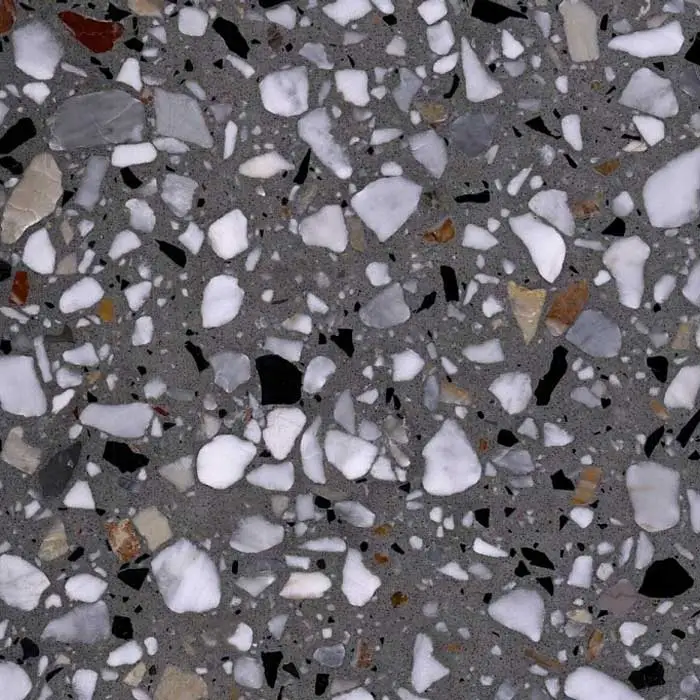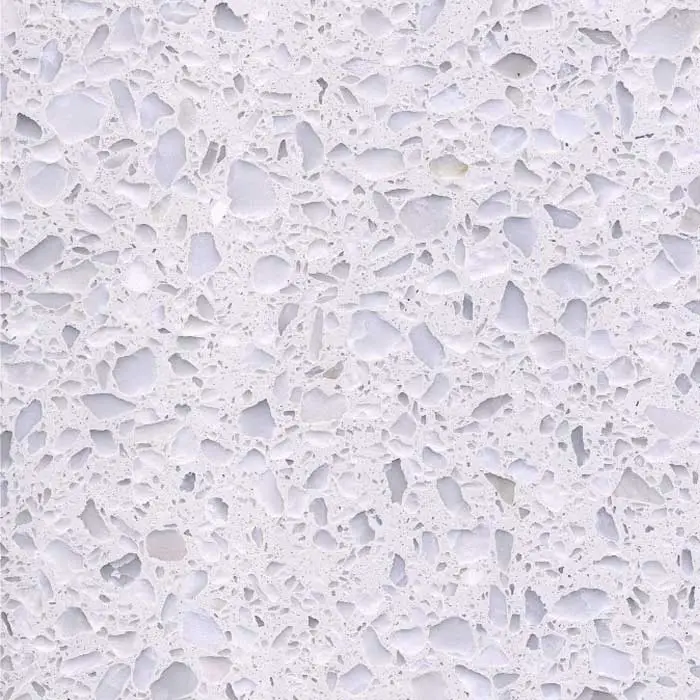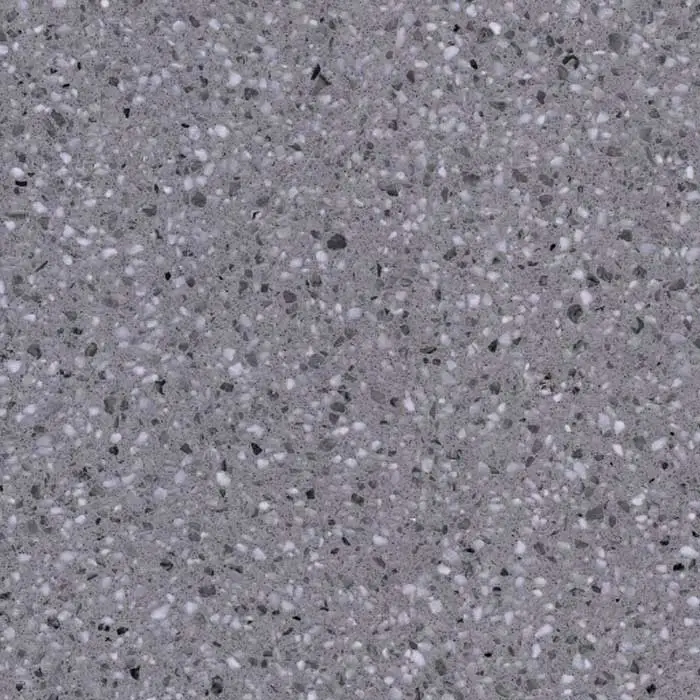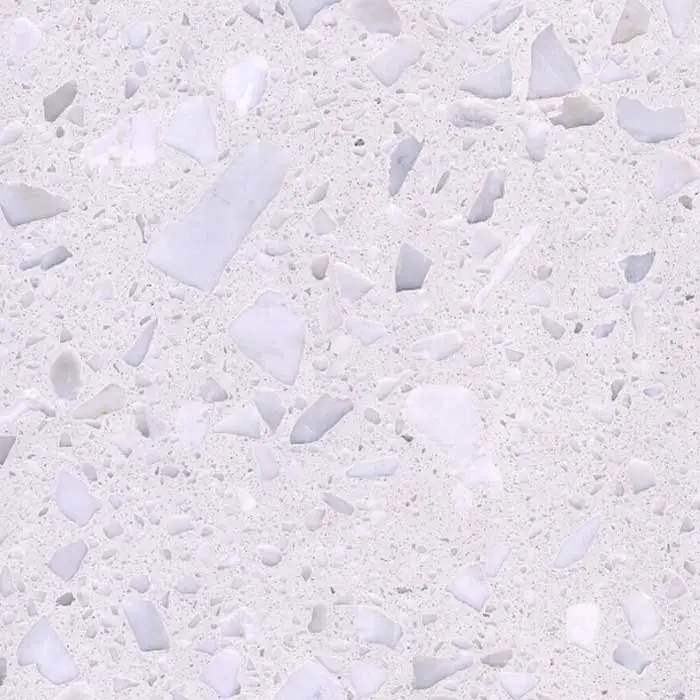As a decorative material with beauty and durability, terrazzo stone flooring is widely used in the field of interior architectural decoration. As people's demand for diversified building materials increases, some people begin to consider applying terrazzo stone flooring to outdoor environments. So, is terrazzo stone flooring suitable for outdoor use?
This article will discuss this issue in detail from multiple aspects such as material properties, climate tolerance, durability, and maintenance requirements.

What is terrazzo stone flooring?
Terrazzo stone flooring is a floor material made by mixing stone particles such as marble and granite with base materials such as cement and resin, and then grinding and polishing them. Its high surface finish, strong hardness, excellent compression resistance, and rich pattern and color options make terrazzo widely used in commercial, residential and other indoor environments. Compared with traditional floor materials such as wood flooring or tiles, terrazzo has the following significant advantages:
1. Strong wear resistance: Terrazzo stone flooring has a high hardness. After polishing, the surface is strong and wear-resistant, suitable for environments with high traffic.
2. Good aesthetics: Terrazzo can be customized in color and pattern according to needs, and its diversity gives designers more creative space.
3. Easy to clean: The surface of the polished terrazzo stone flooring is smooth, not easy to hide dirt, and easy for daily cleaning and maintenance.
4. Moderate cost: Compared with pure stone floors, terrazzo is relatively cheap, but can provide a decorative effect close to stone.
However, whether these characteristics are also applicable in outdoor environments requires further analysis based on the material's weather resistance and weathering resistance.

Weather resistance and weathering resistance of terrazzo stone flooring
The main difference between the outdoor environment and the indoor environment is its more complex climatic conditions, such as direct sunlight, temperature changes, rain and snow erosion, humidity fluctuations, etc. These factors may have a significant impact on the physical and chemical properties of flooring materials. As a composite material based on cement or resin, how terrazzo performs in outdoor environments depends on several key factors:
UV resistance
In outdoor environments, materials need to be exposed to sunlight for a long time, and ultraviolet rays are one of the important reasons for floor aging. If terrazzo stone flooring uses resin materials as a binder, its UV resistance is poor and it is prone to fading, powdering and other problems if exposed to sunlight for a long time. In contrast, cement-based terrazzo stone flooring performs relatively well in terms of UV resistance, but is not completely immune. In areas with strong sunlight, especially in outdoor applications, the color of terrazzo may change to a certain extent over time.
Resistance to temperature changes
The temperature of the outdoor environment fluctuates greatly, especially in winter and summer. In cold weather, cement-based terrazzo may crack or develop surface fissures due to thermal expansion and contraction. Although terrazzo has a high hardness, its ductility is poor. When faced with extreme temperature differences, stress concentration may occur inside the material, causing the micro-cracks in the material to expand, ultimately affecting the structural integrity of the floor.
Resistance to humidity and rain erosion
The porous structure of terrazzo stone flooring makes it absorbent when it comes into contact with water. In outdoor environments, long-term erosion by rainwater can cause the floor to absorb too much moisture, which in turn affects its structural stability. Especially in cold climates, moisture that enters the floor can freeze and expand, further exacerbating the cracking problem. In addition, the cement component in terrazzo may undergo hydration reaction when in contact with water for a long time, causing the precipitation of calcium carbonate on the surface and forming efflorescence, which affects the appearance.
Weathering resistance
Weathering refers to the physical or chemical changes that occur when materials are exposed to the air for a long time and are affected by chemical components such as oxygen and carbon dioxide, as well as the effects of wind and rain. The base materials of terrazzo, such as cement and resin, will gradually lose their original strength and adhesion under the action of weathering, which will manifest as problems such as peeling of the floor surface and enlarged cracks. Therefore, the service life of terrazzo outdoors is generally shorter than that indoors.

Anti-slip and safety of terrazzo stone flooring
Outdoor floors usually need to have certain anti-slip properties, especially in wet weather or rainy and snowy weather. Anti-slip properties become an important indicator to determine whether the floor is suitable for outdoor use. Terrazzo stone flooring has a very smooth surface after polishing, which is one of its advantages in indoor environments, but in outdoor environments, an overly smooth surface may increase the risk of pedestrians slipping, especially after rain or in icy conditions. Down.
Although the coefficient of friction of terrazzo stone flooring can be increased by not polishing or using a rough surface treatment, thereby improving its slip resistance, doing so will affect its aesthetics to a certain extent. Additionally, non-slip treated floor surfaces are more likely to accumulate dirt and require more frequent cleaning and maintenance.
Durability and maintenance requirements of terrazzo stone flooring
Building materials in outdoor environments usually need to have higher durability and lower maintenance requirements to reduce subsequent maintenance costs. Terrazzo stone flooring has certain advantages in durability, especially in terms of resistance to compression and wear, but its maintenance requirements may be higher in outdoor environments.
Cleaning and maintenance frequency
Due to the microporous structure of terrazzo surface, dust, dirt and other pollutants can easily adhere to the floor surface in outdoor environments. If not cleaned regularly, these pollutants will gradually penetrate into the interior of the floor, causing its surface to lose its luster and even cause problems such as mold and mildew. Therefore, terrazzo stone flooring requires more frequent cleaning and polishing when used outdoors to keep its surface smooth and beautiful.
Necessity of protective measures
In order to extend the service life of terrazzo stone flooring in outdoor environments, some protective measures can be taken, such as applying waterproof and UV-proof coatings on the surface to reduce the erosion of the floor by the external environment. However, these coatings often require periodic reapplication, increasing maintenance costs and labor input.
Restoration and renovation
Since terrazzo stone flooring in outdoor environments is easily affected by climate and environment, the possibility of surface damage is greater. Once cracking, falling off and other problems occur, professional repair and renovation are required, which requires high construction technology and relatively high repair costs.

Possibilities and limitations of outdoor applications of terrazzo stone flooring
In summary, terrazzo stone flooring can be used outdoors, but its applicability is subject to many restrictions. First of all, climatic conditions are the key factors affecting its effectiveness. In areas with large temperature differences and strong ultraviolet rays, terrazzo stone flooring is prone to aging, cracking and fading problems. Secondly, terrazzo performs generally in terms of anti-slip and waterproof properties, especially in rainy and snowy weather, which can easily lead to safety hazards. Finally, outdoor use requires higher maintenance costs and frequent cleaning and repair, which places additional demands on users.
Therefore, although terrazzo stone flooring can be used outdoors for a short period of time or for decorative purposes, its durability and economy are not ideal if it is used as the main floor material. If it must be used outdoors, it is recommended to take protective measures, such as adding anti-slip treatment and protective coating to the surface, and perform regular maintenance to extend its service life.
Rongguan, a trusted building material manufacturer, offers unparalleled quality and price competitiveness. Our product lineup includes artificial marble countertops, terrazzo flooring, and premium roof tiles. With a strong export network spanning the USA, EU, and Southeast Asia, we ensure prompt delivery and cost-effective solutions for your projects. Contact us for the best quotes on bulk orders.

